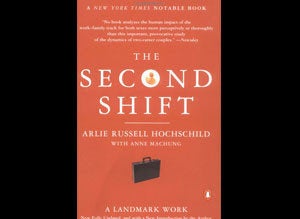
I read "The Second Shift" more than a decade ago, when I was fresh out of graduate school, working at an Internet start up, newly married (to my first husband), and planning to have a child. That book scared the hell out of me.
It was based on research conducted in the 1980s by the prize-winning author and sociologist, Arlie Hochschild, and described the lack of equality between couples in households where both parents worked. The women in the study worked full-time jobs, then came home and made dinner, cleaned the house, bathed the kids, all with very little help from their husbands. Many of them went back to work after the kids went to bed. They were stressed, resentful, burning out.
I vowed never to be trapped like the women in Hochschild's book, and immediately began to have heated arguments with my husband about sharing the mopping of floors and scrubbing of toilets.
Several years later, I lived my own version of the book. Although I was married to a man (my second husband) who pulled his weight at home and in every way imaginable was an equal and loving partner to me, I found the competing demands of a growing career and a growing family beyond grueling.
Every once in a while, I thought about Hochschild's book, and felt a ray of gratitude that the author, without knowing it, had validated the struggle I found myself in.
A new version of "The Second Shift" just came out last month. Imagine my surprise and delight to find out that Hochschild had discovered a story I wrote here on HuffPost and devoted three paragraphs to recounting it in the new Afterward.
But that's not why I think you should read the updated version of "The Second Shift". The author compares the status of working mothers around the time the book was first published to where we are now. Her conclusions are fascinating, heartbreaking, and important food for thought for any woman (or man) who cares about gender equality.
A few ways things have changed since 1975:
- Far more mothers with children under age three work (from one-third to nearly two-thirds).
In other words, we've made progress since my mom was raising me, but we have a long way to go.
Hochschild says the women's movement did a bang-up job empowering women to "stand equal to men". But it failed to value the caring of others.
"Without our noticing, American capitalism over time embraced empowerment and sidetracked care. So in the absence of a countermovement, care has often become a hand-me-down job. Men hand it down to women. High-income women hand it to low-income women. Migrant workers who care for American children and elderly, hand the care of their own children and elderly to paid caregivers as well as grandmothers and aunts back in the Philippines, Sri Lanka, Mexico...[and those] at the end of the care chain pass child-care duties to oldest daughters. The big challenge in the years ahead--the challenge at the heart of this book--is to value and share the duties of caring for loved ones."
What would it look like to value and share the caring of others?
Today, for most professionals -- women and men -- a full-time job means more than 40 hours per week. Many low-wage workers have to work more than one job just to get by -- and studies show Americans work some of the longest hours in the developed world. You can have a perfectly equal marriage at home, but if you're both working 40-plus hours, there simply isn't enough time for the second shift.
How do we get that time back?
Having two working parents does not have to be at odds with our quality of life. Hochschild talks about Norway, which has both the highest rate of working mothers and the highest rate of child well-being. (The U.S. ranks a pitiful 20 out of 21 countries on child well-being, according to a 2007 UNESCO report.)
But Norway has built a society that supports both working moms and dads, with generous paid leave, subsidized childcare, and a 35-hour workweek. Meanwhile, we can't even agree on whether the richest one percent of Americans should be taxed at the rate of Warren Buffet's secretary, but I digress...
What do you think? How do we get our time back, so we can share that second shift?